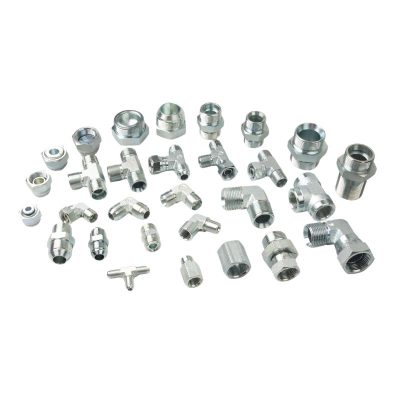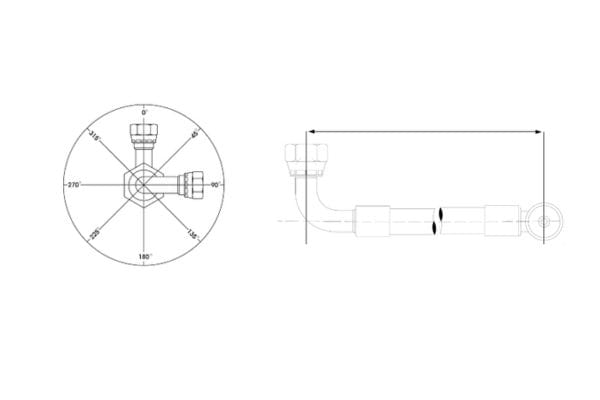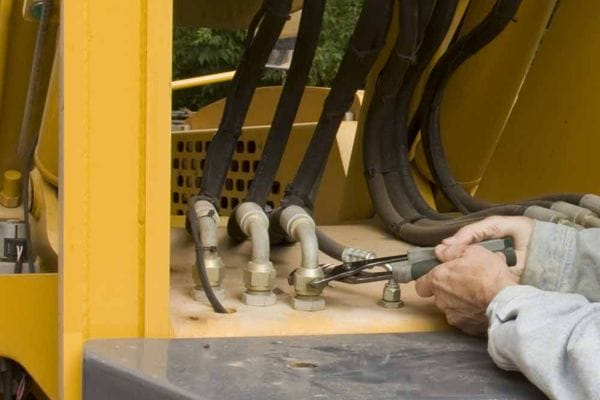Improper orientation can lead to significant issues such as hose twisting, accelerated wear, and potential system malfunctions, which can be costly and dangerous. Hose twisting, for instance, can restrict fluid flow, increase pressure on the hose walls, and lead to premature wear or even catastrophic failure. These problems not only affect the hydraulic system’s performance but also pose serious safety risks to operators and can result in costly downtime and repairs. In this post, readers will learn various techniques and methods to accurately identify hydraulic fitting orientation, enhancing their system’s reliability and efficiency.
Hydraulic fittings come in various types, each designed to serve specific functions within a hydraulic system. Understanding these types is essential for selecting the right fitting for your application and ensuring proper system performance.
Straight Fittings:
Description: Straight fittings are designed for direct, linear connections between hydraulic components. They are simple and efficient, providing a straightforward path for fluid flow.
Applications: These fittings are commonly used in systems where components are aligned in a straight line, minimizing the complexity of the hydraulic layout.
Elbow Fittings:
Description: Elbow fittings enable directional changes in the hydraulic system, typically at 45 or 90-degree angles. They are crucial for routing hoses and pipes around obstacles and within confined spaces.
Applications: Elbow fittings are widely used in systems where the layout requires bends and turns, such as in tight machinery compartments or complex piping networks.
Tee Fittings:
Description: Tee fittings allow for branching connections, dividing the fluid flow into two or more directions from a single source. This type of fitting is essential for distributing fluid to multiple components within the system.
Applications: Tee fittings are utilized in applications where fluid needs to be directed to several locations, such as in multi-cylinder hydraulic systems or branched hydraulic circuits.

Each type of fitting requires specific orientation to ensure proper alignment and function. Misalignment can lead to issues such as leaks, increased wear, and reduced system efficiency. Correctly oriented fittings ensure that the hydraulic system operates smoothly, maintains optimal pressure, and minimizes the risk of component failure. Proper orientation is especially critical in high-pressure applications where even slight misalignments can have significant consequences.
Hydraulic fittings are manufactured from various materials, each selected for its unique properties to suit different operational environments and performance requirements.
Steel:
Steel fittings are known for their high strength and durability. They can withstand high pressure and are suitable for heavy-duty applications.
Brass:
Brass fittings offer excellent corrosion resistance and are less prone to rust and oxidation compared to steel. They are also easier to machine, allowing for precise manufacturing.
Hydraulic fittings are essential in various industries, ensuring efficient and reliable system performance.
Manufacturing: In manufacturing, hydraulic fittings are used in machinery and equipment that require precise fluid control, such as presses, injection molding machines, and automated production lines.
Construction: The construction industry relies on hydraulic fittings to operate heavy machinery like excavators, bulldozers, and cranes, which require robust and reliable hydraulic systems to perform demanding tasks.
Agriculture: In agricultural settings, hydraulic fittings are found in equipment such as tractors, harvesters, and irrigation systems, where they help manage the flow of fluids necessary for efficient operation and productivity.
How Incorrect Orientation Causes Twisting:
Incorrect orientation of hydraulic fittings can lead to significant misalignment issues within the hydraulic system. When fittings are not aligned properly, it forces the connected hoses to twist and bend unnaturally during operation. This misalignment creates undue stress on the hoses, which are designed to operate efficiently only when properly aligned. Over time, this twisting can cause the hose materials to weaken, leading to cracks, splits, and eventual failure.
Consequences of Hose Twisting:
Reduced Lifespan: Twisted hoses are subject to increased wear and tear, significantly reducing their operational lifespan. The constant stress and strain can cause premature aging of the hose material.
Potential Leaks: As the hose materials degrade due to twisting, the risk of leaks increases. Leaks not only waste hydraulic fluid but can also lead to contamination and environmental hazards.
Safety Hazards: Twisted hoses are more likely to fail catastrophically, posing significant safety risks to personnel and equipment. A sudden hose failure can result in high-pressure fluid release, which can cause injuries and damage to the machinery.
Impact on System Performance:
Misaligned fittings and twisted hoses can severely impact the overall performance of a hydraulic system. The primary function of hydraulic systems is to transfer power efficiently through a fluid medium. When fittings are not correctly oriented, it disrupts the smooth flow of hydraulic fluid, leading to several performance issues. These disruptions can compromise the system’s ability to generate and transmit the necessary force and motion required for various operations.
Correct orientation ensures that the hydraulic fluid flows smoothly without encountering unnecessary resistance. When fittings are aligned properly, the hydraulic system operates efficiently, maintaining optimal pressure and flow rates. This efficiency is crucial for the performance of machinery and equipment that rely on hydraulic power for their functions.
Examples of Efficiency Losses:
Energy Loss:
Misalignment creates additional friction and resistance within the hoses, causing the system to work harder to maintain fluid flow. This extra effort results in increased energy consumption and reduced efficiency. The hydraulic pump, which generates the pressure required to move the fluid, has to work harder to overcome these resistances, consuming more power. Over time, this increased energy consumption can significantly raise operational costs, making the system less economical to run. Additionally, the extra load on the pump can lead to its premature wear and failure, necessitating expensive repairs or replacements.
Reduced Hydraulic Power:
Twisted hoses restrict the fluid flow, reducing the system’s hydraulic power. This loss of power can compromise the performance of hydraulic actuators, leading to slower response times and less effective operation. For instance, in a construction machine like an excavator, reduced hydraulic power can result in slower arm movements and decreased lifting capabilities, directly impacting productivity. The compromised flow can also lead to uneven distribution of power across the system, causing some components to work harder than others, which can result in uneven wear and potential failures.
Visual inspection is the most straightforward method to identify fitting orientation. This method involves a thorough examination of the fittings and hoses to check for alignment and any signs of twisting or wear. It is a fundamental technique that allows operators to quickly identify obvious misalignments and potential issues without the need for specialized equipment.
Steps for Conducting a Visual Inspection:
Check for Alignment:
Visually inspect the fittings to ensure they are properly aligned with the hoses. Look for any angles or bends that seem out of place. A straight fitting should be in line with the hose, while elbow and tee fittings should be positioned correctly according to their intended angles.
Examine the hose routing to ensure there are no sharp bends or kinks that could indicate improper fitting orientation. Proper routing should follow smooth, gentle curves.
Signs of Twisting or Wear:
Look for physical signs of twisting or wear on the hoses, such as kinks, cracks, or abrasions. These are indications of improper orientation that can lead to premature hose failure. Twisting often manifests as spiral marks or uneven wear patterns on the hose surface.
Check for signs of leaks around the fittings, as this can also indicate misalignment or improper fitting installation. Leaks can be identified by wetness, fluid stains, or a drop in system pressure.
Tools Needed:
Use basic inspection tools like flashlights to illuminate hard-to-see areas and magnifying glasses to get a closer look at small details. In some cases, mirrors can be used to view fittings and hoses in difficult-to-reach locations.
Having a checklist or guide for visual inspections can help ensure all critical points are examined thoroughly.
The near end method involves assessing the fitting orientation close to the connection point. This method provides a detailed examination of the fitting and its immediate surroundings, ensuring that it is correctly positioned to maintain proper fluid flow.
Detailed Description:
This method focuses on the fitting’s orientation relative to the immediate connection point, ensuring that the fitting is properly aligned with the hose or pipe to maintain optimal fluid flow and pressure.
Step-by-Step Guide:
Identify the Connection Point:
Locate the fitting and its connection point on the hose or pipe. This is the starting point for your assessment.
Ensure the connection is tight and secure, as loose connections can lead to misalignment.
Measure the Angle and Alignment:
Use tools such as protractors or alignment gauges to measure the angle and ensure the fitting is properly aligned. For example, a protractor can help verify that an elbow fitting is at the correct angle.
Check the alignment of the hose or pipe leading to and from the fitting. The hose should be straight and free from any undue stress or bending.

The far-end method involves evaluating the fitting orientation from a distance, providing a broader perspective of the overall alignment. This method is useful for assessing the general routing and positioning of hoses and fittings across the entire system.
Detailed Description:
This method assesses the fitting’s orientation by observing the alignment from a distance, ensuring that the entire hose or pipe system is correctly aligned. It helps to identify overall system layout issues that might not be apparent in a close-up inspection.
Step-by-Step Guide:
Observe the Overall Alignment:
Stand back and observe the entire hose or pipe system to check for overall alignment. Look for any visible bends, kinks, or twists that could indicate misalignment.
Ensure that hoses and pipes follow smooth, natural curves and are properly supported to avoid sagging or undue stress.
Measure the Alignment Using Appropriate Tools:
Use tools like laser levels or string lines to measure the alignment and ensure the fitting is correctly oriented within the system. A laser level can project a straight line along the length of the hose, helping to identify deviations.
Check the consistency of hose and pipe diameters to ensure there are no unexpected restrictions or expansions that could affect fluid flow.

Misalignment of hydraulic fittings can lead to various symptoms that indicate something is wrong with the system. Recognizing these signs early can prevent more significant issues and costly repairs down the line.
Common Symptoms and Signs:
Leaks:
Leaks are one of the most obvious signs of misalignment. They occur when fittings are not properly aligned, causing gaps or pressure points where fluid can escape.
Look for wet spots, dripping fluid, or a decrease in system pressure.
Inefficient System Performance:
Misalignment can cause a reduction in the system’s overall efficiency. You might notice slower actuator movements, reduced power output, or inconsistent operation.
Check for any changes in system performance that could indicate fluid flow is being restricted or disrupted.
Unusual Wear Patterns:
Misaligned fittings can cause hoses and other components to wear unevenly. Look for signs of abrasion, kinks, or twisting on hoses.
Uneven wear patterns on fittings or hoses can indicate that the components are under stress due to improper alignment.
Immediate Steps to Take:
When symptoms of misalignment are detected, it’s crucial to act quickly to prevent further damage.
Isolate the Problem:
Identify the specific area where the issue is occurring. This might involve shutting down the system to prevent further damage and conducting a preliminary inspection to pinpoint the source of the problem.
Conduct a Thorough Inspection:
Perform a detailed examination of the suspected misaligned fitting and surrounding components. Use visual inspection techniques and alignment tools to assess the orientation of the fittings.
Check for additional signs of misalignment or damage in other parts of the system.
Plan for Correction:
Develop a plan to correct the misalignment. This may involve adjusting the orientation of the fittings, replacing damaged components, or rerouting hoses to ensure proper alignment.
Once the misalignment has been identified and a plan is in place, follow these steps to correct the issue and restore proper system function.
Step-by-Step Guide:
Identify the Misaligned Fitting:
Use visual inspection and alignment tools to locate the fitting that is misaligned. Confirm that this fitting is the source of the problem.
Adjust the Orientation Using Appropriate Tools:
Carefully adjust the orientation of the misaligned fitting. Use tools such as wrenches, protractors, and alignment gauges to achieve the correct alignment.
Make small adjustments and recheck the alignment frequently to ensure the fitting is positioned correctly.
Recheck Alignment and Secure the Fitting:
Once the fitting is properly aligned, double-check the alignment to ensure it is correct. Use alignment tools to verify that the fitting is in the optimal position.
Secure the fitting in place, ensuring that all connections are tight and there are no gaps or pressure points.
Proper orientation of hydraulic fittings is crucial for maintaining system efficiency, safety, and longevity. Misaligned fittings can lead to significant issues such as hose twisting, leaks, and reduced system performance, which can be costly and hazardous. By ensuring that hydraulic fittings are correctly oriented, you can enhance the reliability and effectiveness of your hydraulic systems, reduce maintenance costs, and extend the lifespan of components.
Proper orientation ensures efficient fluid flow, prevents hose twisting, reduces wear and tear, and enhances system reliability and safety.
Common signs include leaks, inefficient system performance, and unusual wear patterns on hoses and fittings.
Basic tools like flashlights, magnifying glasses, and sometimes mirrors are needed to check for alignment and signs of wear or twisting.
Identify the misaligned fitting, adjust its orientation using tools like wrenches and protractors, and recheck the alignment to ensure it is correct before securing the fitting.
The near end method involves inspecting the fitting close to the connection point for precise adjustments, while the far end method assesses the overall alignment from a distance to provide a broader perspective.
Regular inspections should be conducted as part of routine maintenance, especially before and after significant operations or if any performance issues are noticed.